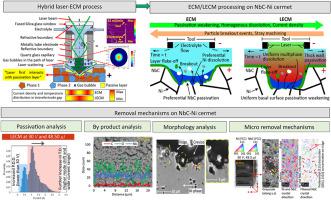当前位置:
X-MOL 学术
›
Int. J. Mach. Tool Manu.
›
论文详情
Our official English website, www.x-mol.net, welcomes your feedback! (Note: you will need to create a separate account there.)
Macro and micro-scale material removal mechanisms during ECM/hybrid laser-ECM of a passivating multiphase NbC–Ni cermet
International Journal of Machine Tools and Manufacture ( IF 14.0 ) Pub Date : 2024-06-26 , DOI: 10.1016/j.ijmachtools.2024.104182 Muhammad Hazak Arshad , Krishna Kumar Saxena , Shuigen Huang , Dominiek Reynaerts
International Journal of Machine Tools and Manufacture ( IF 14.0 ) Pub Date : 2024-06-26 , DOI: 10.1016/j.ijmachtools.2024.104182 Muhammad Hazak Arshad , Krishna Kumar Saxena , Shuigen Huang , Dominiek Reynaerts

|
Electrochemical machining (ECM) is a non-contact and athermal machining process where the material removal is accomplished through controlled anodic dissolution of the workpiece governed by Faraday laws. ECM process has been hybridized with several other processes for improving material processing windows. Hybrid laser electrochemical machining (LECM) synergistically applies electrochemical and laser process energies with added benefits of escalated reaction kinetics leading to enhanced transpassive dissolution, weakening of passivation layer, process localisation and uniform dissolution. The laser energy acts as a localised and controllable heat source thereby offering multi-fold processing benefits. For alloys and cermets, a characteristic surficial fingerprint is the presence of inhomogeneous multiphase dissolution and sporadically distributed passivation layer, necessitating addition of aggressive reagents in electrolytes. LECM has the potential to addresses these challenges while processing in pH neutral electrolytes. Previous works have very limited analysis on the macro and micro removal mechanisms while processing relevant strategic materials and multitude of applications of LECM remain unexploited. Therefore, this work presents in-depth investigations into macro and micro-scale material removal mechanisms of ECM/LECM on sintered niobium carbide with nickel binder (NbC–Ni), which is a potential cobalt-free alternative to tungsten carbide. The results revealed new insights into the removal behaviour of the constituent phases which differed from the first principles and their interaction with the laser. During ECM, the Ni phase dissolved preferentially and influenced the surface pattern and particle breakout which was reduced with laser assistance. The surface evolution characteristics were also analysed based on the ridge-crevice pattern. Additionally, the weakening of passive layer was correlated with the pulse analysis that revealed quantitatively the different process regimes occurring during ECM and LECM. The grain level study revealed that orientation effects still exist during LECM and the grains with higher surface energy (FCC (001) vicinal planes) passivated more and dissolved less. Furthermore, the improvement in surface quality, overcut and reduction in particle breakout with LECM process makes it promising for machining newer recipes of metal carbides.
中文翻译:

钝化多相 NbC-Ni 金属陶瓷 ECM/混合激光 ECM 过程中的宏观和微观材料去除机制
电化学加工 (ECM) 是一种非接触式无热加工工艺,其中材料去除是通过受法拉第定律控制的工件的受控阳极溶解来完成的。 ECM 工艺已与其他几种工艺相结合,以改善材料加工窗口。混合激光电化学加工 (LECM) 协同应用电化学和激光加工能量,具有升级反应动力学的额外优势,从而增强跨钝化溶解、削弱钝化层、过程局部化和均匀溶解。激光能量充当局部且可控的热源,从而提供多重加工优势。对于合金和金属陶瓷,特征性的表面指纹是存在不均匀的多相溶解和零星分布的钝化层,因此需要在电解质中添加腐蚀性试剂。 LECM 有潜力在 pH 中性电解质中处理时解决这些挑战。以前的工作对宏观和微观去除机制的分析非常有限,同时处理相关的战略材料,并且 LECM 的大量应用仍未得到开发。因此,这项工作深入研究了镍粘结剂烧结碳化铌(NbC-Ni)上 ECM/LECM 的宏观和微观材料去除机制,这是碳化钨的潜在无钴替代品。结果揭示了与第一原理不同的组成相去除行为及其与激光相互作用的新见解。在 ECM 过程中,Ni 相优先溶解并影响表面图案和颗粒破裂,而激光辅助可减少这种情况。 还根据脊缝模式分析了表面演化特征。此外,钝化层的弱化与脉冲分析相关,脉冲分析定量地揭示了 ECM 和 LECM 期间发生的不同工艺状态。晶粒水平研究表明,LECM 过程中仍然存在取向效应,并且表面能较高的晶粒(FCC (001) 邻面)钝化较多,溶解较少。此外,LECM 工艺改善了表面质量、过切并减少了颗粒破碎,使其有望用于加工新配方的金属碳化物。
更新日期:2024-06-26
中文翻译:

钝化多相 NbC-Ni 金属陶瓷 ECM/混合激光 ECM 过程中的宏观和微观材料去除机制
电化学加工 (ECM) 是一种非接触式无热加工工艺,其中材料去除是通过受法拉第定律控制的工件的受控阳极溶解来完成的。 ECM 工艺已与其他几种工艺相结合,以改善材料加工窗口。混合激光电化学加工 (LECM) 协同应用电化学和激光加工能量,具有升级反应动力学的额外优势,从而增强跨钝化溶解、削弱钝化层、过程局部化和均匀溶解。激光能量充当局部且可控的热源,从而提供多重加工优势。对于合金和金属陶瓷,特征性的表面指纹是存在不均匀的多相溶解和零星分布的钝化层,因此需要在电解质中添加腐蚀性试剂。 LECM 有潜力在 pH 中性电解质中处理时解决这些挑战。以前的工作对宏观和微观去除机制的分析非常有限,同时处理相关的战略材料,并且 LECM 的大量应用仍未得到开发。因此,这项工作深入研究了镍粘结剂烧结碳化铌(NbC-Ni)上 ECM/LECM 的宏观和微观材料去除机制,这是碳化钨的潜在无钴替代品。结果揭示了与第一原理不同的组成相去除行为及其与激光相互作用的新见解。在 ECM 过程中,Ni 相优先溶解并影响表面图案和颗粒破裂,而激光辅助可减少这种情况。 还根据脊缝模式分析了表面演化特征。此外,钝化层的弱化与脉冲分析相关,脉冲分析定量地揭示了 ECM 和 LECM 期间发生的不同工艺状态。晶粒水平研究表明,LECM 过程中仍然存在取向效应,并且表面能较高的晶粒(FCC (001) 邻面)钝化较多,溶解较少。此外,LECM 工艺改善了表面质量、过切并减少了颗粒破碎,使其有望用于加工新配方的金属碳化物。












































 京公网安备 11010802027423号
京公网安备 11010802027423号